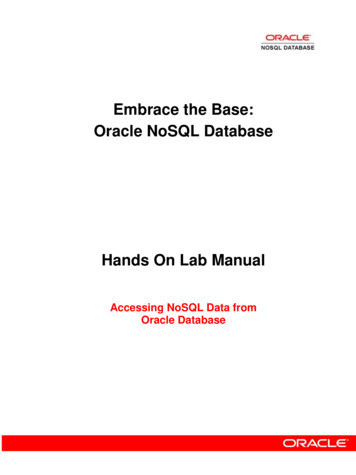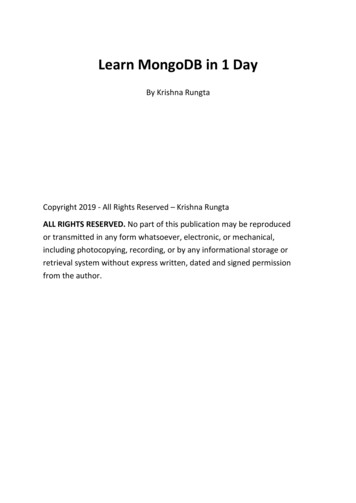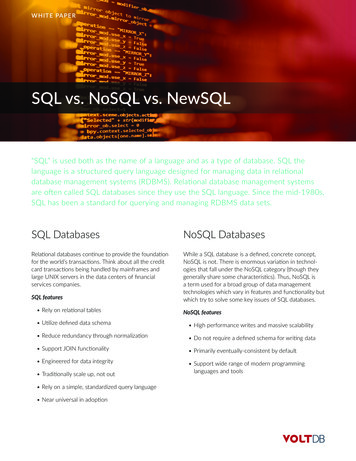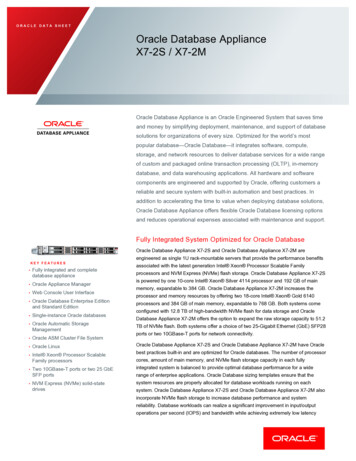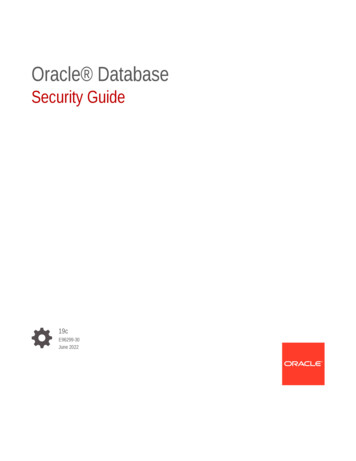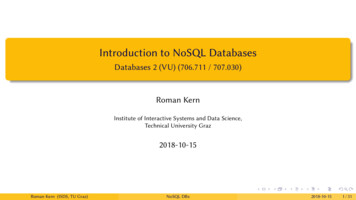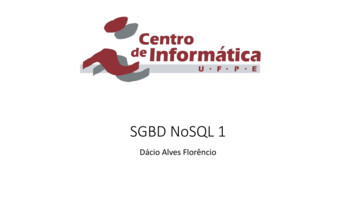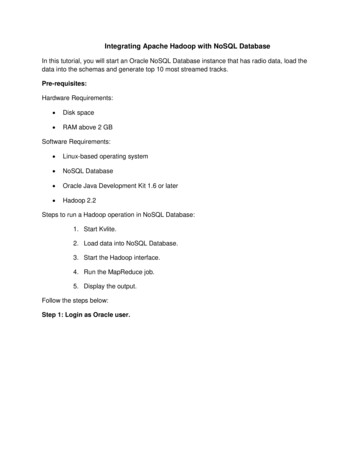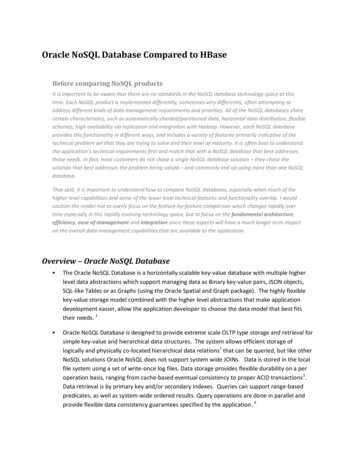
Transcription
Oracle NoSQL Database Compared to HBaseBefore comparing NoSQL productsIt is important to be aware that there are no standards in the NoSQL database technology space at thistime. Each NoSQL product is implemented differently, sometimes very differently, often attempting toaddress different kinds of data management requirements and priorities. All of the NoSQL databases sharecertain characteristics, such as automatically sharded/partitioned data, horizontal data distribution, flexibleschemas, high availability via replication and integration with Hadoop. However, each NoSQL databaseprovides this functionality in different ways, and includes a variety of features primarily indicative of thetechnical problem set that they are trying to solve and their level of maturity. It is often best to understandthe application’s technical requirements first and match that with a NoSQL database that best addressesthose needs. In fact, most customers do not chose a single NoSQL database solution – they chose thesolution that best addresses the problem being solved – and commonly end up using more than one NoSQLdatabase.That said, it is important to understand how to compare NoSQL databases, especially when much of thehigher level capabilities and some of the lower level technical features and functionality overlap. I wouldcaution the reader not to overly focus on the feature-by-feature comparison which changes rapidly overtime especially in this rapidly evolving technology space, but to focus on the fundamental architecture,efficiency, ease of management and integration since these aspects will have a much longer term impacton the overall data management capabilities that are available to the application.Overview – Oracle NoSQL Database The Oracle NoSQL Database is a horizontally scalable key-value database with multiple higherlevel data abstractions which support managing data as Binary key-value pairs, JSON objects,SQL-like Tables or as Graphs (using the Oracle Spatial and Graph package). The highly flexiblekey-value storage model combined with the higher level abstractions that make applicationdevelopment easier, allow the application developer to choose the data model that best fitstheir needs. 1 Oracle NoSQL Database is designed to provide extreme scale OLTP type storage and retrieval forsimple key-value and hierarchical data structures. The system allows efficient storage oflogically and physically co-located hierarchical data relations2 that can be queried, but like otherNoSQL solutions Oracle NoSQL does not support system wide JOINs. Data is stored in the localfile system using a set of write-once log files. Data storage provides flexible durability on a peroperation basis, ranging from cache-based eventual consistency to proper ACID transactions3.Data retrieval is by primary key and/or secondary indexes. Queries can support range-basedpredicates, as well as system-wide ordered results. Query operations are done in parallel andprovide flexible data consistency guarantees specified by the application. 4
Oracle NoSQL Database secondary indices are implemented using distributed, shard-local Btrees. This implementation provides highly scalable, low-latency transactionally consistentsecondary indices as well as parallelized secondary index search. Additionally, Oracle NoSQLDatabase supports secondary indexing over simple, scalar as well as over non-scalar and nesteddata values. Oracle NoSQL Database uses a distributed, shared-nothing architecture which scales datastorage and processing horizontally across commodity servers using a hashing algorithm andintelligent client drivers. Oracle NoSQL Database uses a PAXOS leader as the coordinator fordata replication, based on the replication configuration for the system. The system supportsdefining Zones of Availability (akin to “data centers”), including Primary and Secondary zones.Each Availability Zone contains one or more copies of all of the data managed by the system.Replication between Availability Zones is automatically enforced to ensure that the data sets arekept up to date. 5 The Oracle NoSQL Database unique intelligent client driver design includes cluster topology,cluster status and performance, as well as automated routing information. This providesautomated topology management6, out-of-the-box data distribution and cluster load balancing7of query requests. Oracle NoSQL Database is not an island of data management technology – it is part of integratedspectrum of data management technologies. Customers need to integrate NoSQL datamanagement with other innovative technology options AND with their existing Oracle datamanagement and application infrastructure. Oracle NoSQL Database is integrated with crucialBig Data open source technologies like Hadoop, MapReduce, Spark, Hive, etc., as well as withOracle technologies like Oracle Database, Coherence, Event Processing, Real Time Decisions,Graph and Spatial and Big Data SQL. Additionally, NoSQL DB can be found on Oracle EngineeredSystems such as the Oracle Big Data Appliance. This is a critical distinction for Oracle NoSQLDatabase. HBase is focused on integration with the emerging Big Data open source technologies,but largely leaves integration with exiting data management infrastructure as an exercise for theuser. Oracle NoSQL Database integrates with both environments. Unlike many other NoSQL products which rely on newly-minted storage, transaction andrecovery technology, Oracle NoSQL Database is based on proven, reliable, mission-critical datastorage technology – namely Berkeley DB. Berkeley DB is used in millions of productioninstallations and provides the data storage, transactions, recovery, indexing and replicationtechnology for Oracle NoSQL.Overview - HBase HBase is a key-value store that supports a single data abstraction known as table-structure(popularly referred to as column family). It is based on the Google Big Table design. HBase isdesigned to work on top of the HDFS (Hadoop Distributed File System). HBase accesses HDFSstorage blocks directly and storing a natively managed file type. 8 The physical storage is similar
to a column oriented database and as such works particularly well for queries involvingaggregations, similar to the shared nothing analytic databases AsterData, GreenPlum, etc. HBase uses a partitioned/sharded data and master-slave distribution architecture, where data ishashed and sent to a set of external master processes known as “Region Servers” each of whichare responsible for managing a subset of the key space. The Region Servers write the data (thruseveral layers of indirection) to HDFS which handles data availability thru file system replication.The Region Servers also make the data available to one additional process which can serve readrequests. 9 The Region Servers and HDFS must be configured and managed separately fromHBase and requires additional open source software components to be installed and configured,including Zookeeper. Some of the major challenges with HBase include: Increased hardware requirements (primary processors and memory) due to the fact thatit relies on a multiple processes running on special-purpose servers that are configuredspecifically for that use. More complex configuration and management due to the fact that it relies on separateconfiguration and management of multiple open source packages in order to providethe basic NoSQL functionality. More complex troubleshooting and system performance management due to thenumber of sheer number of packages and configurations required. Less performance and throughput for record-based operations.
ComparisonThe table below gives a high level comparison of Oracle NoSQL Database and HBase.FeatureOracle NoSQL ed, centralized,packaged configuration &administrationStorage ModelSelf-managed, local files usinglog-based file system,optimized for high recordbased read/write throughputData AccessSingle-hop data access. Built-intopology and latency-awareclient driver maps data tostorage location(s). Operationssent directly from the clientapplication to the appropriatestorage node.Driver dynamically adjusts tochanging topology andthroughput.HBaseImpactRequires Hadoop, HDFS,NoSQL DB is much simpler toZookeeper and other open configure, deploy, manage andsource packagestroubleshoot Lower risk Lower Cost of Ownership (Less HWIndividual administrationrequired Lower administrativeof required packagesburden) Better manageability of largeclustersUses HDFS (HadoopNoSQL DB has better performance, isDistributed File System)simpler to manage Lower Cost of Ownership (Less HWRequires separaterequired Lower administrativeadministrationburden Simpler to troubleshoot andtune)HDFS is optimized forlarge block I/O, notrecord-based I/O requiredby OLTP NoSQLapplications8Multi-hop data access.NoSQL DB has better performanceSeparately managedbecause it requires only a single hopName and Region servers to access data, requires no additionalmap data to storagemanagementlocation(s). Operations Lower riskfunneled through one or Lower Cost of Ownership (Less HWmore servers torequired Lower administrativeappropriate HDFS storage. burden)
Partitions, grouped into shardsScale OutBuilt-in, re-distribution ofpartitions in background task ashardware is added, optionaloperator-invoked re-balancingavailableSimple scale out due to sharednothing client-server topology– simply add more nodes toscaleDatacenters(AvailabilityZones)Primary and Secondary DataCenters. Built-in synchronousand asynchronous replicationbetween DCs. Reads can be DCspecific.Built-in, configurable,integrated with transactionsub-systemReplicationBasis for HA and scalabilityUses Berkeley DB – 20 yearsof field validationIntegrationIntegrated with Big Datatechnology stack.Shards, grouped intoregions. Regionsautomatically split andredistribute growing data(significant performanceissue)Regions, crash recoveryand scaling requireoperator/DBAinterventionMulti-server, multi-regioncomplex topologyHBase Regions can bereplicated across DCs.Requires separateconfiguration &management.Combines HDFS in-clusterreplication and internalintra-cluster replicationwhich is configured andmanaged separatelyHBase has been anApache project for 6 yearsIntegrated with Big Datatechnology stack only.Integrated with Oracletechnology.NoSQL DB is simpler to configure,expand and manage, designed forconsistent, predictable throughput.Performance and managementdifferences more significant as thecluster grows. More predictable performance Lower Cost of Ownership (Less HWrequired Lower administrativeburden) Better manageability of largeclustersNoSQL DB is simpler to configure andhas more application options Shorter time to market Lower Cost of Ownership (Loweradministrative burden)NoSQL DB replication is easier tomanage, more automatic andintegrated. NoSQL is more maturebased on 20 years of field validation Lower Risk Lower Cost of Ownership (Loweradministrative burden)NoSQL DB integrates with new ITprojects as well as existing ITinfrastructure Shorter time to market Lower Cost of Ownership (Lowerimplementation cost)NoSQL DB has more configurationoptions Better fit for some applications Shorter time to marketConfigurable ACID and BASEtransactionsStrongly consistent reads& writesData ModelSupport for Key-Value Pairs,JSON objects, Tables, GraphDataColumn-family Tables.NoSQL DB has more developeroptions Shorter time to market1APIsAPIs for Java, C, REST, ThriftAPIs for Java, Jython,Groovy, REST, ThriftSimilar API choices, better API supportfor NoSQL10 Lower risk Enterprise-class SupportTransactionsandConcurrencyAPIs for JavaScript, Python, C#planned for early 2015Many open source APIs
Web-based monitoring,Command Line Interface.MonitoringandAdministrationIntegrated with OracleEnterprise Manager.JMX and SNMP interfacesupports 3rd party plug-ins.Command Line Interface.Open Source communitysupported graphical tools.NoSQL DB leverages OEM integration Enterprise-class Support Lower Cost of Ownership (Loweradministrative burden because ofOEM skills re-use)
Oracle NoSQL Database Proof PointsNTT DocomoNTT Docomo uses Oracle NoSQL DB to provide a Digital Marketplace for millions of their smart phoneusers. The DM provides web-based DRM information, configuration management and productrecommendations on a per-user/per-device basis. NTT benchmarked their application against OracleNoSQL DB and HBase to assess the long term cost of ownership, based on the hardware required tosustain the target throughput (transactions per second). They determined that Oracle NoSQL DB wouldbe much more cost effective because it required less hardware. See the use case here.
Internal YCSB BenchmarksOracle Engineering ran an internal benchmark, comparing Oracle NoSQL DB against HBase using YCSB.Tests were run on the Oracle Big Data Appliance using a 6 and 12 node cluster. YCSB is an OLTP-style,record-based application benchmark. Oracle NoSQL Database demonstrated better query performanceand lower latency as well as more predictable scalability as the size of the cluster grew.
1Passoker was able to reduce their application Time-to-Market by 75% because they were able to save time onapplication development and QA due their use of the flexible data modeling options in Oracle NoSQL Database.More information available here: 36620012All of the records which share the same Shard key are co-located within the same Storage Node on disk. Thissupports ACID transactions because NoSQL DB can ensure that reads and writes within the same storage node areare transactionally consistent. This also supports low-latency data access of related data records because all of therecords can be managed by accessing a single storage node.3Oracle NoSQL Database supports both eventually consistent or BASE transactions as well as traditional ACIDtransactions. BASE transactions are often used by customers who want to increase data access throughput, but arewilling to tolerate potentially inconsistent results or loss of data in the event of system failure. ACID transactionsare often required by applications that can NOT tolerate inconsistent results or loss of data in the event of systemfailure. For many applications it is important to provide BOTH types of transactions, however most NoSQL systemssupport one other, but not both. HBase has a more limited range of transaction options than Oracle NoSQL DB.4Queries in Oracle NoSQL Database are automatically run in parallel across shards, when appropriate (table scansand secondary index searches for example). The application controls how many parallel threads are executed andthe batch size of each thread. This is an important application performance tuning feature, as it allows theapplication to control the degree of parallelization executed for a given query, thereby controlling the impact ofthe execution on the overall system. For example, low latency interactive secondary index lookups (that will likelyreturn few results) can be configured for maximum parallelization and batch size so that results are returnedfaster, where as higher latency report-style scans can be configured to reduce the impact on the system.5The intelligent NoSQL DB client driver is Availability Zone-aware. Queries can be specifically directed by theapplication to one or more Availability Zones. This can be used by the application to restrict reporting, statisticaland batch processing-like queries to specific Availability Zone(s), thereby reducing their impact to throughput andperformance on the production portion of the NoSQL cluster.6The intelligent NoSQL DB client driver has the advantage that it can automatically respond and adjust to changesin the NoSQL cluster topology. For example, if a given Storage Node fails (or is taken offline), the client driver isnotified of the topology change and can automatically direct queries to the appropriate surviving Storage Nodes.Conversely, if additional Storage Nodes are added or the NoSQL cluster is rebalanced, the NoSQL DB driver canimmediately start utilizing the newly available hardware (and throughput).7The NoSQL DB driver includes performance statistics for each Storage Node, allowing it to dynamically adjustquery load balancing if a Storage Node(s) throughput starts to change due to other queries that may be accessingthe affected Storage Node(s), increasing queries if the SN is more responsive or directing queries to alternate SNs ifthe SN has become less responsive.8HDFS as a file system, is tuned for large block I/O and as such is not very efficient at individual record read/writeoperations. Oracle NoSQL Database’s log-structured files stored in the local file system is tuned for high volume,low latency read and write operations on specific records. Customers have found that HBase works very well forbatch oriented bulk read/write data management, but that Oracle NoSQL DB provides better per-recordoperational throughput. This can be verified using the Yahoo Cloud Services Benchmark (YCSB) and is validated byNTT Docomo in their Digital Marketplace use case mentioned earlier in the document.9This is distinctly different from Oracle NoSQL Database which allows the customer to determine how many readreplicas are needed in order to meet their concurrency requirements. Additionally, Oracle NoSQL Database uses anintegrated, optimized in-memory and process-based replication architecture for high availability rather thanrelying on the external file system (HDFS). Oracle NoSQL DB offers a more simplified, easily managed, more tightlyintegrated solution.10Although there are many HBase open source APIs available, support and committers can be spotty. Open sourceAPIs run the risk that committers are not available or have other priorities. Oracle provides enterprise-classsupport for all of the supported APIs available on Oracle NoSQL DB.
Database. HBase is focused on integration with the emerging Big Data open source technologies, but largely leaves integration with exiting data management infrastructure as an exercise for the user. Oracle NoSQL Database integrates with both environments. Unlike many other NoSQL products which rely on newly-minted storage, transaction and
